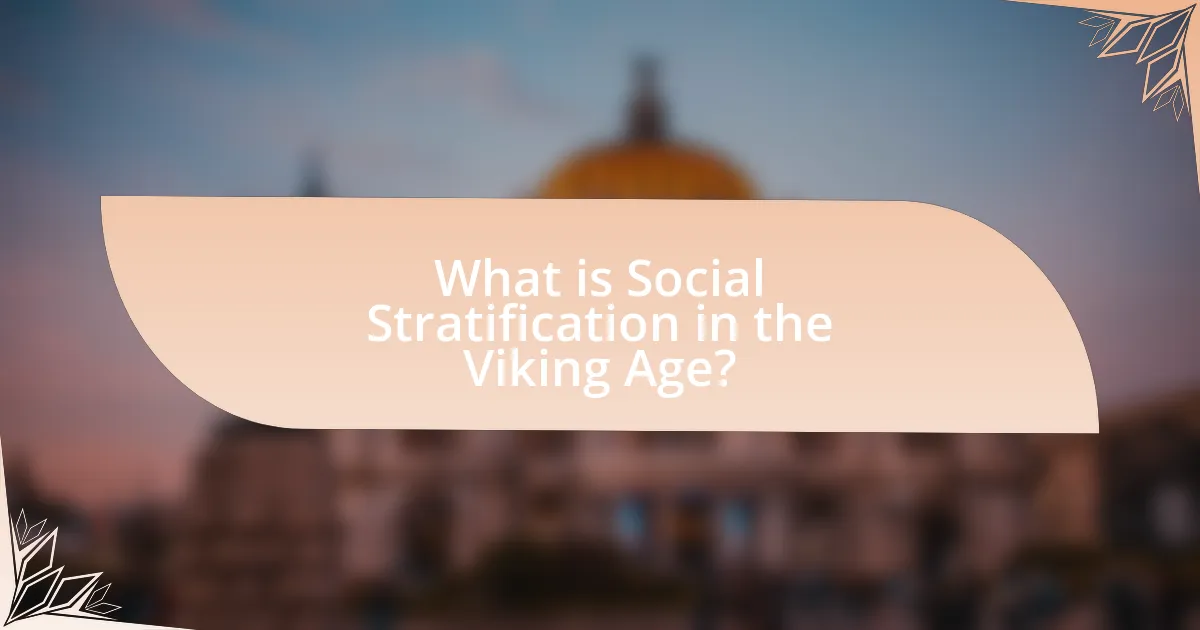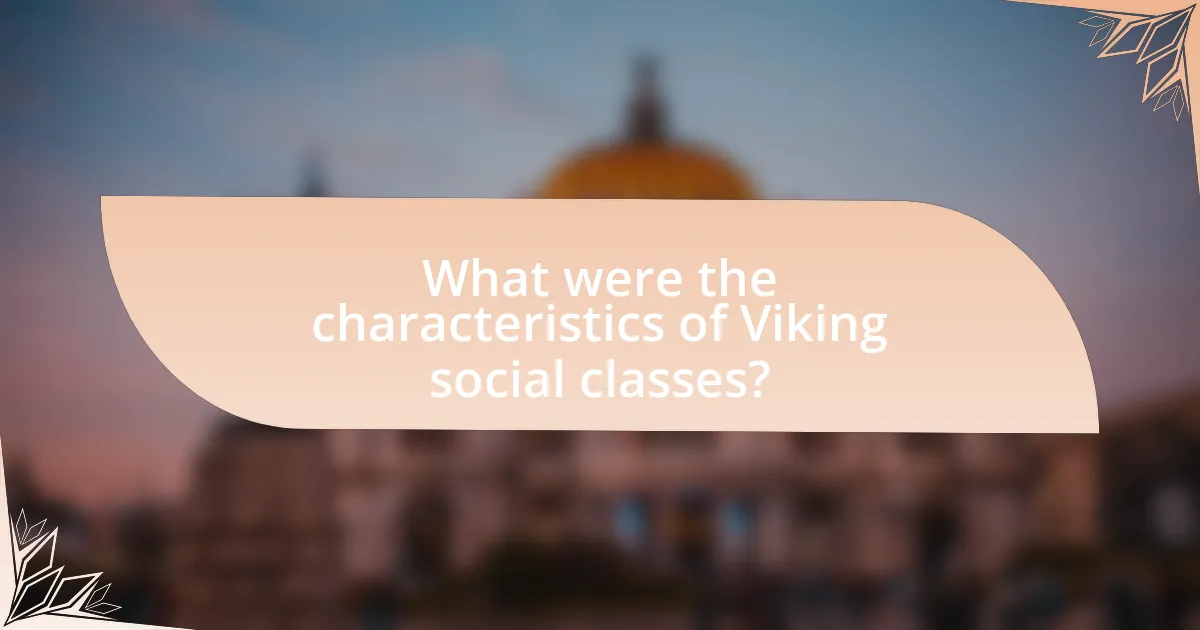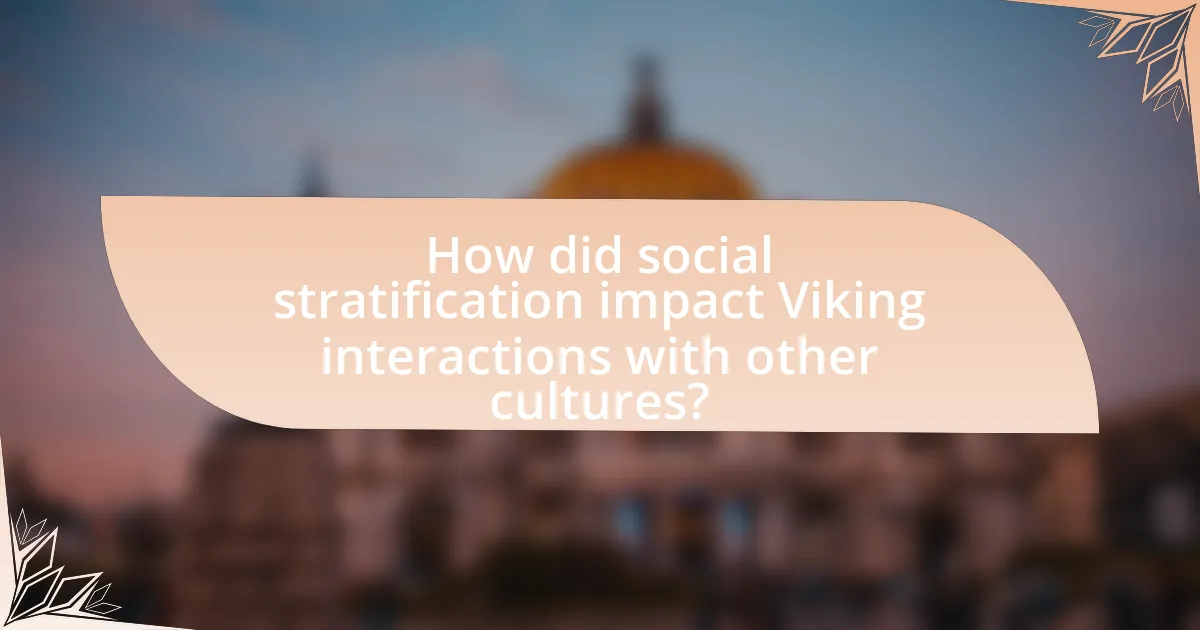Social stratification in the Viking Age refers to the hierarchical organization of society based on wealth, power, and social status, encompassing distinct classes such as nobles (jarls), free farmers (karls), and thralls (slaves). This article examines how social stratification manifested in Viking society, detailing the roles and privileges of each class, the influence of wealth and power on social status, and the significance of these structures in shaping Viking culture and interactions with other societies. Key insights include the impact of gender dynamics on social mobility, the roles of different classes in trade and warfare, and the broader implications of Viking social hierarchies for understanding contemporary social structures.

What is Social Stratification in the Viking Age?
Social stratification in the Viking Age refers to the hierarchical organization of society based on wealth, power, and social status. This stratification was characterized by distinct classes, including the nobility (jarls), free farmers (karls), and thralls (slaves), each with specific roles and privileges. Historical evidence, such as archaeological findings and sagas, indicates that jarls held significant political and economic power, while karls were landowners and warriors, and thralls performed labor-intensive tasks. This structure influenced social interactions, resource distribution, and community organization within Viking society.
How did social stratification manifest in Viking society?
Social stratification in Viking society manifested through a hierarchical structure that categorized individuals into distinct social classes, primarily including nobles, freemen, and thralls. Nobles, or jarls, held significant power and wealth, often controlling land and resources, while freemen, or karls, engaged in farming, trading, and craftsmanship. Thralls, the lowest class, were enslaved individuals who performed labor for their owners. This stratification was evident in burial practices, where the wealth and status of individuals were reflected in grave goods and burial mounds, with more elaborate graves indicating higher social standing. Historical evidence, such as the archaeological findings at sites like Oseberg and Gokstad, supports this social hierarchy, showcasing the differences in grave goods and burial rites among the classes.
What were the key social classes in Viking Age society?
The key social classes in Viking Age society were the nobles, freemen, and thralls. Nobles, or jarls, held significant power and land, often leading clans and engaging in trade and warfare. Freemen, known as karls, were independent farmers and craftsmen who had rights and could participate in local assemblies. Thralls were enslaved individuals who performed labor and had no rights, often captured in raids or born into servitude. This social structure was essential for understanding the dynamics of Viking society and its economic and political organization.
How did wealth and power influence social status among Vikings?
Wealth and power significantly influenced social status among Vikings by determining an individual’s position within the hierarchical structure of Viking society. The wealthiest individuals, often chieftains or landowners, commanded respect and authority, which was reflected in their ability to lead raids, acquire resources, and maintain followers. Historical evidence shows that wealth was often measured in livestock, land, and precious metals, which directly correlated with a person’s influence and social standing. For instance, the sagas illustrate that successful warriors who amassed wealth through plunder gained higher status, as they could host feasts and distribute gifts, further solidifying their power and prestige within the community.
Why is it important to study social stratification in the Viking Age?
Studying social stratification in the Viking Age is important because it reveals the hierarchical structures that influenced social interactions, power dynamics, and economic relationships within Viking societies. Understanding these stratifications helps historians and archaeologists analyze how wealth, status, and roles were distributed among different groups, such as nobles, freemen, and slaves. For instance, archaeological findings, such as grave goods and settlement patterns, indicate that wealth was concentrated among elite classes, which shaped their political and military power. This analysis provides insights into the social organization and cultural practices of the Viking Age, contributing to a broader understanding of their impact on European history.
What insights can we gain about Viking culture from social stratification?
Social stratification in Viking culture reveals a hierarchical society characterized by distinct social classes, including nobles, freemen, and thralls. This stratification indicates the importance of wealth, land ownership, and warrior status in determining an individual’s role and influence within the community. Evidence from archaeological findings, such as grave goods and settlement patterns, shows that elite individuals were buried with valuable items, signifying their high status and the societal value placed on wealth and power. Additionally, the presence of thralls, who were often captured in raids or born into servitude, highlights the reliance on forced labor and the social acceptance of inequality. These insights illustrate how social stratification shaped Viking identity, governance, and economic practices, reflecting broader cultural values and social dynamics.
How does social stratification in the Viking Age compare to other historical societies?
Social stratification in the Viking Age was characterized by a relatively fluid hierarchy compared to other historical societies, such as feudal Europe or ancient Rome. In the Viking Age, society was divided into distinct classes, including nobles, freemen, and thralls, but social mobility was possible through wealth accumulation, warfare, or successful trade. This contrasts with the rigid class structures of feudal Europe, where serfs had limited opportunities for upward mobility, and ancient Rome, where social status was often hereditary and dictated by birth. Evidence from archaeological findings, such as grave goods and settlement patterns, indicates that Viking leaders could rise from lower classes, reflecting a more dynamic social structure.

What were the characteristics of Viking social classes?
Viking social classes were characterized by a hierarchical structure consisting of three main groups: nobles, freemen, and thralls. Nobles, or jarls, held significant power and wealth, often owning large estates and leading clans. Freemen, known as karls, were independent farmers or craftsmen who had the right to own land and participate in local governance. Thralls, the lowest class, were enslaved individuals who worked for others and had no personal freedom. This social stratification was evident in Viking society, where wealth and status determined one’s role and influence, as supported by archaeological findings that reveal distinct burial practices and grave goods associated with each class.
What roles did different social classes play in Viking society?
In Viking society, different social classes played distinct roles that were crucial for the functioning of their communities. The highest class, known as the nobles or jarls, held political power, led raids, and managed land, while the freemen, or karls, were farmers, craftsmen, and traders who contributed to the economy and military. The lowest class, known as thralls, were enslaved individuals who performed labor-intensive tasks and had no personal freedom. Historical evidence, such as the Icelandic sagas and archaeological findings, illustrates these roles, showing that jarls organized expeditions, karls cultivated land and engaged in trade, and thralls provided essential labor for agricultural and domestic work.
How did the roles of nobles differ from those of commoners?
Nobles in the Viking Age held significant power and privilege, primarily serving as landowners, military leaders, and political figures, while commoners were primarily engaged in agriculture, trade, and craftsmanship. Nobles often controlled large estates and had the authority to make legal decisions, whereas commoners had limited rights and were subject to the nobles’ rule. Historical evidence shows that nobles participated in the Thing, a governing assembly, influencing laws and policies, while commoners had little to no representation in such matters. This distinction in roles highlights the hierarchical structure of Viking society, where nobles wielded authority and resources that were inaccessible to commoners.
What was the significance of the thrall class in Viking society?
The thrall class was significant in Viking society as it represented the lowest social tier, primarily composed of enslaved individuals who performed essential labor. Thralls were crucial for agricultural work, household tasks, and skilled trades, thereby supporting the economy and sustaining the households of free Vikings. Historical records indicate that thralls could be acquired through warfare, trade, or birth, and their labor was vital for the prosperity of Viking communities, allowing free individuals to engage in trade, exploration, and warfare. The existence of the thrall class also reinforced social hierarchies, as it established a clear distinction between the free and the unfree, shaping the social dynamics of Viking society.
How did gender influence social stratification in the Viking Age?
Gender significantly influenced social stratification in the Viking Age by determining roles, status, and access to resources within society. Men predominantly held positions of power, engaging in warfare and leadership, which reinforced their higher social status. In contrast, women, while often responsible for domestic duties, could also attain considerable influence, particularly in managing households and property, as evidenced by archaeological findings of women’s graves containing valuable goods. This duality illustrates that while men were typically seen as the primary decision-makers, women could exert influence in specific contexts, such as through marriage alliances or economic control, thereby contributing to a complex social hierarchy.
What roles did women occupy within the Viking social hierarchy?
Women in the Viking social hierarchy occupied various roles, including those of household managers, landowners, and participants in trade and craft production. They were responsible for managing domestic affairs, which included overseeing the household, raising children, and maintaining the farm. Evidence from archaeological findings, such as grave goods and settlement patterns, indicates that women could inherit and own property, which granted them a degree of economic power. Additionally, some women engaged in trade, as seen in historical accounts of women participating in markets and crafting goods for sale. These roles highlight the significant, albeit often underrepresented, contributions of women in Viking society.
How did gender dynamics affect social mobility in Viking society?
Gender dynamics significantly influenced social mobility in Viking society by allowing women to hold property and manage households, which provided them with avenues for economic independence. Women in Viking culture could inherit land and wealth, enabling them to elevate their social status and that of their families. Historical evidence shows that women like the legendary figure Freydis Eiríksdóttir participated in exploration and trade, illustrating their active roles in society. Additionally, archaeological findings indicate that women were buried with valuable goods, suggesting their importance and status within the community. This ability to own property and engage in trade contributed to a more fluid social structure, where both men and women could potentially rise in status based on their economic contributions.

How did social stratification impact Viking interactions with other cultures?
Social stratification significantly influenced Viking interactions with other cultures by determining the roles and behaviors of different social classes during trade, warfare, and diplomacy. The Viking society was divided into distinct classes, including nobles, freemen, and thralls, which dictated their access to resources and decision-making power. For instance, the elite class often engaged in diplomatic relations and trade negotiations, while lower classes participated in raiding and labor. This hierarchical structure facilitated complex interactions; nobles would establish alliances with foreign leaders, while warriors would conduct raids that led to cultural exchanges and the spread of Viking influence. Historical evidence shows that Viking leaders, such as Harald Bluetooth, utilized their status to forge alliances with Christian kingdoms, thereby impacting religious and cultural dynamics across Europe.
What were the effects of social stratification on Viking trade relationships?
Social stratification significantly influenced Viking trade relationships by creating distinct social classes that dictated access to resources and trade networks. The elite, including chieftains and wealthy merchants, controlled trade routes and established partnerships with foreign traders, enhancing their economic power. In contrast, lower classes, such as farmers and laborers, had limited access to these networks, which restricted their participation in trade. This hierarchical structure fostered a system where the elite could monopolize valuable goods, such as silver and luxury items, while the lower classes primarily engaged in local trade, reinforcing economic disparities. Historical evidence shows that Viking leaders often used wealth acquired through trade to solidify their status and power, further entrenching social stratification within their communities.
How did social status influence trade practices among Vikings?
Social status significantly influenced trade practices among Vikings by determining access to resources, trading networks, and the types of goods exchanged. Higher-status individuals, such as chieftains and wealthy merchants, had greater control over trade routes and could engage in long-distance trade, acquiring luxury items like silver, spices, and textiles. In contrast, lower-status individuals typically participated in local trade, exchanging everyday goods and necessities. Archaeological evidence, such as the discovery of wealthier graves containing imported goods, supports the notion that social stratification directly impacted the scale and scope of trade activities among different Viking classes.
What role did social stratification play in Viking raids and conquests?
Social stratification significantly influenced Viking raids and conquests by determining the social roles and motivations of individuals involved. The Viking society was hierarchically structured, with a clear distinction between nobles, freemen, and thralls, which shaped their military organization and objectives. Nobles, or jarls, often led raids to gain wealth and prestige, while freemen participated for opportunities to improve their social standing. Historical evidence shows that successful raids could elevate a freeman to a higher status, as seen in the accounts of warriors who returned with plunder and land, thus reinforcing the social mobility aspect of Viking culture. This stratification not only motivated individuals but also organized their collective efforts, making raids a means of both economic gain and social advancement.
How did social stratification shape Viking political structures?
Social stratification significantly influenced Viking political structures by establishing a hierarchy that determined power dynamics and governance. The Viking society was divided into distinct classes, including nobles, freemen, and thralls, which dictated political roles and responsibilities. Nobles, or jarls, held substantial authority, leading military campaigns and making crucial decisions, while freemen participated in local assemblies called things, where they could voice opinions and influence laws. Thralls, as the lowest class, had no political power, reinforcing the dominance of higher classes. This stratification created a system where political authority was concentrated among the elite, shaping governance and societal organization in Viking communities.
What influence did social hierarchy have on leadership and governance in Viking communities?
Social hierarchy significantly influenced leadership and governance in Viking communities by establishing a clear structure of power and authority. In these societies, leaders known as chieftains or kings emerged from the upper echelons of the social hierarchy, often based on noble lineage or wealth, which granted them the legitimacy to govern. This stratification allowed for organized decision-making and resource allocation, as leaders were expected to protect their followers and manage communal affairs. Historical evidence shows that the Thing, an assembly of free men, played a crucial role in governance, but it was typically dominated by those of higher social status, reinforcing the influence of hierarchy in political processes. Additionally, the distribution of land and wealth among the elite shaped the social dynamics, as powerful families often controlled local governance and military resources, further entrenching their authority within Viking communities.
What lessons can we learn from the social stratification of the Viking Age?
The social stratification of the Viking Age teaches us about the complexities of power dynamics and resource distribution in early societies. During this period, society was divided into distinct classes, including nobles, freemen, and thralls, which influenced social mobility and access to resources. Historical evidence shows that the nobility held significant power and wealth, often controlling land and trade routes, while thralls, who were often captured in raids, had limited rights and opportunities for advancement. This stratification highlights how social hierarchies can shape individual lives and community structures, as well as the potential for conflict arising from inequality. Understanding these dynamics can inform contemporary discussions about social justice and economic disparity.
How can understanding Viking social structures inform our view of modern societies?
Understanding Viking social structures can inform our view of modern societies by highlighting the complexities of social stratification and the roles of leadership, kinship, and economic exchange. Viking society was organized into distinct classes, including nobles, freemen, and thralls, which illustrates how social hierarchies can influence power dynamics and resource distribution. For instance, the presence of a warrior elite among the Vikings, who gained status through military success and land ownership, parallels modern societal structures where wealth and influence often dictate social standing. Additionally, the importance of kinship ties in Viking culture emphasizes how familial relationships can shape social networks and community support systems, reflecting similar patterns in contemporary societies where social capital is crucial for success. This comparative analysis reveals that understanding historical social structures can provide insights into the ongoing relevance of class, power, and community in today’s world.
What best practices can be derived from the study of Viking social stratification?
The best practices derived from the study of Viking social stratification include recognizing the importance of hierarchical structures in societal organization and understanding the roles of different social classes in community dynamics. Viking society was characterized by a clear stratification system, with nobles, freemen, and thralls, each having distinct responsibilities and privileges. This stratification facilitated resource allocation, conflict resolution, and social cohesion, as evidenced by archaeological findings that show varying burial practices and grave goods associated with different social classes. Such practices highlight the significance of social roles in maintaining order and stability within the community, providing a framework for analyzing contemporary social structures.